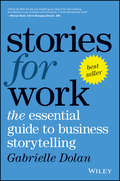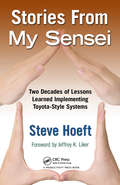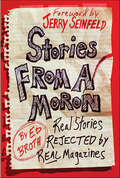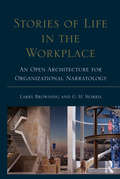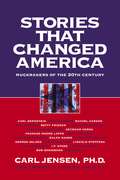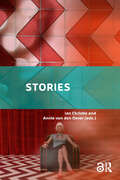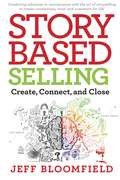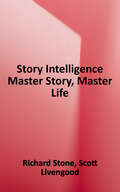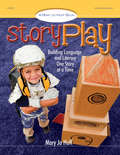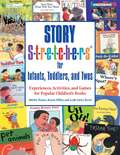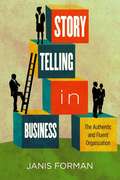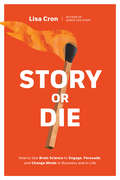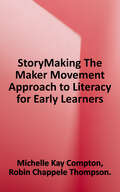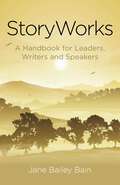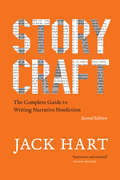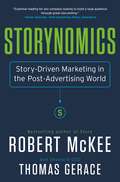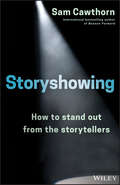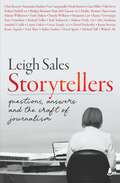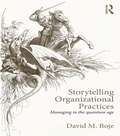- Table View
- List View
Stories for Work: The Essential Guide to Business Storytelling
by Gabrielle DolanLearn the science and master the art of telling a great story Stories for Work walks you through the science of storytelling, revealing the secrets behind great storytellers and showing you how to master the art of storytelling in business. Stories hold a unique place in our psyche, and the right story at the right time can be a game-changer in business; whether tragedy, triumph, tension or transition, a good story can captivate the listener and help you achieve your goals. In this book, author Gabrielle Dolan draws from a decade of training business leaders in storytelling to show you what works, why it works, when it works best and what never works. You'll learn how to create your own stories — authentically yours, crafted to attain your goal — and develop an instinct for sharing when the time is right. In-depth case studies feature real-world people in real-world businesses, showing how storytelling has changed the way they work, motivate and lead — providing clear examples of the power of this enormously effective skill. Storytelling gives you an edge. Whether you're after a promotion, a difficult client, a big sale or leading through transition, a great story can help you smooth the road and seal the deal. This book is your personal coach for masterful storytelling, with expert guidance and lessons learned from real-world business leaders. Learn why storytelling grabs attention and helps your message get through Master the four types of stories used in business settings Infuse your stories with the personal to highlight your vision and values Craft a selection of stories to pull out at pivotal business moments The oral tradition has ancient roots that unite all humans, and despite our myriad modern distractions, we still respond to a well-told story. Stories for Work helps you put this dynamic to work for you in any business scenario.
Stories from My Sensei: Two Decades of Lessons Learned Implementing Toyota-Style Systems
by Steve HoeftIn the tradition of Taoist philosophers and Zen masters, Steve Hoeft tells the stories he learned from his Toyota Production System (TPS) master teachers. Sometimes enigmatic, sometimes funny, but always powerful and enlightening, these stories of continuous improvement and Lean implementation are organized around the Toyota House framework. After
Stories from a Moron: Real Stories Rejected by Real Magazines
by Ed BrothA nutty and hilarious book of magazine submissions and letters to and from the editors by the comedian, former Seinfeld writer, and Bee Movie cowriter.Foreword by Jerry SeinfeldEd writes short stories. He’s prolific. And desperate to get published. But he sends his stories to the wrong magazines. As for the magazines? Well, they don’t mind telling him so:“As a word of advice, it always helps for writers to be familiar with the publications they submit material to.” —Fencers Quarterly Magazine“Dear Ed: Thank you for your recent submission to Steamboat Magazine; it was wonderful to hear how much our magazine has touched you . . .”“Dear Mr. Broth: Thank you for the opportunity to review your article, ‘My Car Ride with Daddy,’ for possible publication in Mushing . . .”With this book, Ed Broth finally sees his work published. His “Stories of Hope & Inspiration” and his “Stories of Meaning & Sacrament” plus his passionate pitches to place his writing in our nation’s premier publications—from Pest Control Magazine to Arthritis Today—are all to be found in the book you hold in your hands.Some might have advised Ed not to send his story “I Love Dogs” to I Love Cats Magazine or to stop submitting revised stories to editors who have already turned them down. But, well, that’s just not the way Ed’s mind works. Studded like a rich cranberry strudel with nuggets of genius—from cartoons and advertisements to Ed’s newspaper articles from across the country—Stories from a Moron is an addictive journey into the mind of a great talent.
Stories of Life in the Workplace: An Open Architecture for Organizational Narratology (Routledge Communication Series)
by George H. Morris Larry BrowningAddressing both renowned theories and standard applications, Stories of Life in the Workplace explains how stories affect human practices and organizational life. Authors Larry Browning and George H. Morris explore how we experience, interpret, and personalize narrative stories in our everyday lives, and how these communicative acts impact our social aims and interactions. In pushing the boundaries of how we perceive narrative and organization, the authors include stories that are broadly applicable across all concepts and experiences. With a perception of narrative and its organizational application, chapters focus on areas such as pedagogy, therapy, project management, strategic planning, public communication, and organizational culture. Readers will learn to: differentiate and gain an in-depth understanding of perspectives from varying narrators; recognize how stories are constructed and used in organizations, and modify the stories they tell; view stories as a means to promote an open exchange of creativity. By integrating a range of theories and practices, Browning and Morris write for an audience of narrative novices and scholars alike. With a distinctive approach and original insight, Stories of Life in the Workplace shows how individuality, developing culture, and the psychology of the self are constructed with language—and how the acceptance of one’s self is accomplished by reaffirming and rearranging one’s story.
Stories that Changed America: Muckrakers of the 20th Century
by Hugh Downs Carl JensenExuberantly written, highly informative, Jensen's Stories That Changed America examines the work of twenty-one investigative writers, and how their efforts forever changed our country. Here are the pioneering muckrakers, like Upton Sinclair, author of the fact-based novel The Jungle, that inspired Theodore Roosevelt to sign the Pure Food and Drug Act into law; "Queen of the Muckrakers" Ida Mae Tarbell, whose McClure magazine exposés led to the dissolution of Standard Oil's monopoly; and Lincoln Steffens, a reporter who unearthed corruption in both municipal and federal governments. You'll also meet Margaret Sanger, the former nurse who coined the term "birth control"; George Seldes, the most censored journalist in American history; Nobel Prize-winning novelist John Steinbeck; environmentalist Rachel Carson; National Organization of Women founder Betty Friedan; African American activist Malcolm X; consumer advocate Ralph Nader; and Bob Woodward and Carl Bernstein, the Pulitzer Prize-winning reporters whose Watergate break-in coverage brought down President Richard Nixon. The courageous writers Jensen includes in this deftly researched volume dedicated their lives to fight for social, civil, political and environmental rights with their mighty pens.
Stories: Screen Narrative in the Digital Era (The Key Debates: Mutations and Appropriations in European Film Studies)
by Ian Christie van den Oever, AnnieStories are perceived as central to modern life. Not only in narrative entertainment media, such as television, cinema, theater, but also in social media. Telling/having a story is widely deemed essential, in business as well as in social life. Does this mark an intensification of what has always been part of human cultures; or has the realm of story expanded to dominate twenty-first century discourse? Addressing stories is an obvious priority for the Key Debates series, and Volume 7, edited by Ian Christie and Annie van den Oever, identifies new phenomena in this field — complex narration, puzzle films, transmedia storytelling — as well as new approaches to understanding these, within narratology and bio-cultural studies. Chapters on such extended television series as Twin Peaks, Game of Thrones and Dickensian explore distinctively new forms of screen storytelling in the digital age. With contributions by Vincent Amiel, Jan Baetens, Dominique Chateau, Ian Christie, John Ellis, Miklós Kiss, Eric de Kuyper, Sandra Laugier, Luke McKernan, José Moure, Roger Odin, Annie van den Oever, Melanie Schiller, Steven Willemsen, Robert Ziegler.
Story Based Selling
by Jeff BloomfieldAs a founder of a successful organization that trains and develops sales professionals, Jeff Bloomfield has given a lot of thought to why customers say yes. In Story-Based Selling: Create, Connect, and Close, Mr. Bloomfield says it's really no mystery. People buy from people they trust. They trust people they like, and they like people they connect to. And he believes that storytelling is the best way for salespeople-and all of us-to immediately connect to a customer's feelings of trust and liking. He thinks teaching sales professionals to close a deal by presenting their product, probing its mutual benefits, and overcoming the customer's objections and skepticism, is a waste of time. Instead, he urges them to tell a great story. Mr. Bloomfield calls upon the latest research in neuroscience to explain the process of communication. The truth is that during the salesperson's engagement with clients, people quickly base their decisions on how they feel, not the way they think, so trying to persuade someone by first imparting lifeless facts and figures is self-defeating. In fact, this information goes right to an area of the listener's brain (the left brain) that drives doubt and skepticism. To make a deal we need to connect with the parts of the customer's brain that inspire emotions of trust and empathy. By telling a story, we can immediately connect to these good gut feelings and drive away the client's fear of being sold. Mr. Bloomfield tells his own engaging stories while teaching step-by-step techniques of intentional storytelling-to create a fast connection with the listener, no matter who is buying or what a person wants to sell.
Story Dash: Find, Develop, and Activate Your Most Valuable Business Stories . . . In Just a Few Hours
by David HutchensStorytelling is humanity&’s oldest way of connecting to others. But for businesses and managers, it can also be a powerful tool to help organizations grow and thrive. A leader&’s role is to create engagement and belief so that people will act. And there&’s no more powerful way to grab attention, be remembered, and engage action than by telling stories—about who you are, what you do, and why you do it. Today, &“storytelling&” is a hot topic in organizations… but most leaders still struggle to act upon it. How do we find and tell our stories quickly, in an environment of urgency where we can hardly pause to catch our breath? For more than a decade Hutchens has tested his method of rapid and strategic story development with innovation teams in Silicon Valley, across global Fortune 100 leadership teams, and more. Hutchens has honed a unique process that is active, potent, and strategically focused . . . and also a lot of fun. In Story Dash, Hutchens shares a repeatable process to find, develop, and deploy your &“narrative assets&”—that is, your urgent core stories that hold value. Even better, he will help you do it FAST; often in less than a day. Story Dash will help you to: Access your natural capacity for storytelling Find your stories—and figure out which ones to tell Build your narrative so it lands with unforgettable impact Find your own voice of authentic leadership Bring more of who you are to your teams and your markets Fully illustrated and written in a clear, sharp voice, Story Dash shares the fastest way to find lots of stories that will create action around the work you care about most.
Story Intelligence: Master Story, Master Life
by Richard Stone Scott LivengoodThis book helps you become a master of your story, a pursuit indispensable to personal and professional success. By developing your SQ, you'll amplify and unleash every aspect of your intelligence, including your IQ and EQ. In this book, you'll also learn how you're wired for a story and the ways it can set a positive trajectory for every facet of your life journey. Developing this level of mastery is imperative today because four in ten Americans have not discovered a satisfying life purpose. Nearly a quarter of us-about one hundred million people-do not have a strong sense of what makes our lives meaningful. We need more than ever ritual fires where we can gather to create new stories that transcend the old metanarratives that no longer enrich and satisfy the yearnings of our hearts and souls. Story is a potent medicine that can re-enchant our lives. By re-storying ourselves, consciously building it into everyday living, we can make space to hear ourselves better, listen more deeply to each other, and discern the tales the earth is quietly whispering in our ears. Hopefully, Story Intelligence will help you stoke a new kind of fire, assisting you in illuminating what the Japanese call "ikigai"-translated loosely as "that which most makes one's life seem worth living." Through mastering story, we believe you can build a more durable source of meaning and personal fulfillment, as well as have a broader impact for good in your community and the world. In this book, you'll also learn how to: harness the power of story to live with greater efficacy; become a more influential communicator; solve complex challenges using story-based solutions; transform your workplace and community; heal old wounds, change dysfunctional beliefs, and bridge differences by resolving deeply seated conflicts; and, acquire the narrative tools to craft a more desirable future.
Story Play: Building Language and Literacy One Story at a Time
by Mary Jo HuffWhen a story comes to "The End" it does not have to be the end of the story. Instead, teachers can continue the learning with activities and experiences to promote conversation about that story. Story Play encourages even the most inexperienced teacher, librarian, child care professional, or family member to become a storyteller with ideas for expanding stories into meaningful learning experiences. With stories, poems, songs, chants, and fingerplays, as well as ideas for working with puppets and props, Story Play brings all the fun of storytelling into the classroom in new ways. These easy-to-follow ideas focus on literacy skills and are perfect for engaged, active learning.
Story S-t-r-e-t-c-h-e-r-s for the Primary Grades, Revised: Activities to Expand Children's Books, Revised Edition
by Brian Scott Smith Shirley RainesThere is nothing that children love more than a good story. Story S-t-r-e-t-c-h-e-r-s for the Primary Grades, Revised connects 90 of the best children's books to early learning centers, stretching each story five ways with lively and entertaining activities that heighten reading readiness, sharpen comprehension skills, and expand the excitement of story time. Pulling the best stories from the original books, this new edition also features new children's books as well as old favorites, refreshed activities, and online references for expanding story experiences.
Story Telling in Business: The Authentic and Fluent Organization
by Janis FormanStorytelling can be a lifelong and life sustaining habit of mind, a personal inheritance that connects us to our communities. It can also serve as an organizational inheritance—a management tool that helps businesses to develop and thrive. For more than a decade, award-winning author Janis Forman has been helping executives to tell stories in service of their organizational objectives. In Storytelling in Business: The Authentic and Fluent Organization, she teaches readers everywhere how the craft of storytelling can help them to achieve their professional goals. Focusing on the role of storytelling at the enterprise level, this book provides a research-driven framework for engaging in organizational storytelling. Forman presents original cases from Chevron, FedEx, Phillips, and Schering-Plough. Organizations like those featured in the book can make use of storytelling for good purposes, such as making sense of their strategy, communicating it, and developing or strengthening culture and brand. These uses of storytelling generate positive consequences that can have a sustained and significant impact on an organization. While large firms employ teams of digital and communication professionals, there's much that any of us can extrapolate from their experience to create stories to further our own objectives. To show the reach of storytelling, Forman conducted 140 interviews with professionals ranging from CEOs in small and thriving firms, to corporate communication and digital media experts, to filmmakers—arguably the world experts in visual storytelling. She draws out specific lessons learned, and shows how to employ the road-tested strategies demonstrated by these leaders. Although this book focuses on storytelling in the context of business, Forman takes inspiration from narratives in literature and film, philosophical and social thought, and relevant concepts from a variety of other disciplines to instruct the reader on how to develop truly authentic and meaningful tales to drive success. A final chapter brings readers back to square one: the development of their own "signature story." This book is a pioneering work that guides us beyond the pressure and noise of daily organizational life to influence people in a sustained, powerful way. It teaches us to be fluent storytellers who succeed by mastering this vital skill.
Story or Die: How to Use Brain Science to Engage, Persuade, and Change Minds in Business and in Life
by Lisa Cron&“A practical, heartfelt manual for anyone who needs to change minds and actions. Lisa Cron shares the art of practical empathy with leaders who care enough to make a difference.&”—Seth Godin, author of The Practice A step-by-step guide to using the brain&’s hardwired need for story to achieve any goal, from the author of Wired for Story Whether you&’re pitching a product, saving the planet, or convincing your kids not to text and drive, story isn&’t just one way to persuade. It&’s the way. It&’s built into the architecture of the brain, and has been since early humans gathered around the camp fire, trying to figure out how to outsmart the lion next door.In Story or Die, story coach Lisa Cron sets out to decode the power of story, first by examining how the brain processes information, translates it into narrative, and then guards it as if your life depends on it. Armed with that insight, she focuses on how to find your real target audience and then pinpoint their hidden resistance. Finally, she takes you, step-by-step, through the creation of your own story, one that allows your audience to overcome their resistance and take up your call to action, not because you told them to, but because they want to.That is the power of story. Use it wisely.
StoryMaking: The Maker Movement Approach to Literacy for Early Learners
by Robin Chappele Thompson Michelle Kay ComptonAfter studying the current research on literacy learning for young children, delving into the beliefs and schools of Reggio Emilia, and discovering the Maker Movement, the authors created StoryMaking. With great success, they implemented it in their diverse and large public school district. StoryMaking shares the processes, first steps, next steps, use for materials, and lessons learned so teachers can implement their versions in their classrooms. The book shares practical suggestions, student samples, photographs, anchor charts, and other forms of documentation.
StoryWorks: A Handbook for Leaders, Writers and Speakers
by Jane Bailey BainInspirational leaders know the power of story. Top coaches use words as a tool for personal transformation. Great speakers and writers realize the importance of narrative. Do you have a new idea? A good proposal? A great product? The best way to sell it is by telling a story. This book shows you how to do that effectively. /StoryWorks/ is a practical handbook on how to tell stories. It ranges from classic tools like the &‘Rule of Threes&’ to the new mnemonic &‘Five Finger Technique&’. There are stories and creative exercises to expand your narrative repertoire. If you&’re a leader who wants to communicate well, a professional keen to improve your speaking skills, a manager with a team to motivate or a writer looking for more ideas – you&’ll find resources here to inspire, to inform and to entertain. Whether you have one minute to impress at an interview or the keynote speech at a conference, this book will help you tell better stories.
Storybrand 2.0 Edición actualizada: Clarifica tu mensaje y los clientes escucharán
by Donald MillerEn StoryBrand 2.0 Edición actualizada, Donald Miller, autor best seller del New York Times, enseña a vendedores y empresarios la forma de utilizar su sistema totalmente revisado de los siete elementos universales de las historias poderosas para mejorar de manera drástica la forma en que conectan con los clientes y hacen crecer sus negocios.Si utilizas las palabras equivocadas para hablar de tu producto, nadie lo comprará. Los vendedores y empresarios luchan por conectar eficazmente con sus clientes, lo que les cuesta a ellos y a sus empresas millones en ingresos perdidos.El proceso StoryBrand creado por Donald Miller es una solución probada en la lucha a la que se enfrentan los líderes empresariales cuando hablan de sus empresas. Sin un mensaje claro y definido, los clientes no entenderán lo que tú puedes hacer por ellos y no estarán dispuestos a comprometerse, lo que te hará perder ventas potenciales, oportunidades de compromiso con el cliente y mucho más.Este probado proceso ha ayudado a miles de empresas a conectar con sus clientes actuales, proporcionándoles la ventaja competitiva definitiva. StoryBrand 2.0 Edición Actualizada hace esto al enseñarte lo siguiente:Los siete puntos universales de la historia a los que todos los seres humanos responden;la verdadera razón por la que los clientes compran;Cómo simplificar un mensaje de marca para que la gente lo entienda; yCómo crear los mensajes más eficaces para sitios web, folletos y redes sociales.Tanto si eres el director de marketing de una empresa multimillonaria, el propietario de una pequeña empresa, un político que se presenta a las elecciones o el cantante de un grupo de rock, StoryBrand 2.0 Edición Actualizada transformará para siempre tu forma de hablar sobre quién eres, qué haces y el valor único que aportas a tus clientes.Building a StoryBrand 2.0In StoryBrand 2.0 Updated Edition, New York Times best-selling author Donald Miller teaches marketers and business owners to use his fully revised system of the seven universal elements of powerful stories to dramatically improve how they connect with customers and grow their businesses.If you use the wrong words to talk about your product, nobody will buy it. Marketers and business owners struggle to effectively connect with their customers, costing them and their companies millions in lost revenue.The StoryBrand process created by Donald Miller is a proven solution to the struggle business leaders face when talking about their companies. Without a clear, distinct message, customers will not understand what you can do for them and are unwilling to engage, causing you to lose potential sales, opportunities for customer engagement, and much more.His proven process has helped thousands of companies engage with their existing customers, giving them the ultimate competitive advantage. StoryBrand 2.0 Updated Editiondoes this by teaching you:The seven universal story points all humans respond to;The real reason customers make purchases;How to simplify a brand message so people understand it; andHow to create the most effective messaging for websites, brochures, and social media.
Storycatcher: Making Sense of Our Lives Through the Power and Practice of Story
by Christina BaldwinStory is the heart of language. Story emotionally moves us to love and hate and can motivate us to change the whole course of our lives. Story can lift us beyond the borders of our individuality to imagine realities of other people, times, and places; to empathize with other beings; to extend our supposing far into the universe. Storytelling - both oral tradition and written word - is the foundation of being human. In her powerful new book, Christina Baldwin, one of the visionaries who started the personal writing movement, explores the vital necessity of re-creating a sacred common ground for each other's stories. Each chapter in Storycatcher is carried by a fascinating tale - about people, family, or community - intertwined with practical instruction about the nature of story, how it works and how we can practise it in our lives. The art of storycatching invites us to spend time speaking and listening, writing and reading, reclaiming the meaning missing from our lives. This book passionately calls for humanity to hang on to its voice, its love of reading and writing, and its understanding that story is our soul. Whether exploring the personal stories revealed in our private journals, the stories of family legacy, the underlying stories that drive our organizations, or the stories that define our broadest definitions of identity, Christina encourages us all to become storycatchers - people who value story and find ways in the midst of everyday life to practise storytelling. Baldwin shows us how new stories lay the framework for a new world.
Storycraft, Second Edition: The Complete Guide to Writing Narrative Nonfiction (Chicago Guides to Writing, Editing, and Publishing)
by Jack HartJack Hart, master writing coach and former managing editor of the Oregonian, has guided several Pulitzer Prize–winning narratives to publication. Since its publication in 2011, his book Storycraft has become the definitive guide to crafting narrative nonfiction. This is the book to read to learn the art of storytelling as embodied in the work of writers such as David Grann, Mary Roach, Tracy Kidder, and John McPhee. In this new edition, Hart has expanded the book’s range to delve into podcasting and has incorporated new insights from recent research into storytelling and the brain. He has also added dozens of new examples that illustrate effective narrative nonfiction. This edition of Storycraft is also paired with Wordcraft, a new incarnation of Hart’s earlier book A Writer’s Coach, now also available from Chicago.
Storycraft, Second Edition: The Complete Guide to Writing Narrative Nonfiction (Chicago Guides to Writing, Editing, and Publishing)
by Jack HartJack Hart, master writing coach and former managing editor of the Oregonian, has guided several Pulitzer Prize–winning narratives to publication. Since its publication in 2011, his book Storycraft has become the definitive guide to crafting narrative nonfiction. This is the book to read to learn the art of storytelling as embodied in the work of writers such as David Grann, Mary Roach, Tracy Kidder, and John McPhee. In this new edition, Hart has expanded the book’s range to delve into podcasting and has incorporated new insights from recent research into storytelling and the brain. He has also added dozens of new examples that illustrate effective narrative nonfiction. This edition of Storycraft is also paired with Wordcraft, a new incarnation of Hart’s earlier book A Writer’s Coach, now also available from Chicago.
Storynomics: Story-Driven Marketing in the Post-Advertising World
by Robert Mckee Thomas GeraceBased on the hottest, most in-demand seminar offered by the legendary story master Robert McKee -- STORYNOMICS translates the lessons of storytelling in business into economic and leadership success.Robert McKee's popular writing workshops have earned him an international reputation. The list of alumni with Academy Awards and Emmy Awards runs off the page. The cornerstone of his program is his singular book, Story, which has defined how we talk about the art of story creation.Now in STORYNOMICS, McKee partners with digital marketing expert and Skyword CEO Tom Gerace to map a path for brands seeking to navigate the rapid decline of interrupt advertising. After successfully guiding organizations as diverse as Samsung, Marriott International, Philips, Microsoft, Nike, IBM, and Siemens to transform their marketing from an ad-centric to story-centric approach, McKee and Gerace now bring this knowledge to business leaders and entrepreneurs alike.Drawing from dozens of story-driven strategies and case studies taken from leading B2B and B2C brands, STORYNOMICS demonstrates how original storytelling delivers results that surpass traditional advertising. How will brands and their customers connect in the future? STORYNOMICS provides the answer.
Storyshowing: How to Stand Out from the Storytellers
by Sam CawthornTake your audience on a journey to leave a more lasting impact Storyshowing is an instruction manual for making connections. Storytelling has been shown to be one of the most effective methods of persuasion, motivation and inspiration, yet the disconnect remains — you're still only telling. To truly influence people, you need to go deeper than that — you need to show them your story. By inviting your audience in, you connect on a much deeper, more emotional level; you bypass the brain and connect at the root of what it means to be human, leaving a profound impact on their entire outlook. This book shows you how to transcend telling and start showing your story, using an easy-to-follow framework you can start applying today. Unearth your own experiences, and bring your vulnerabilities out into the light; share your emotions and forge a path to true communication. Use images, body language and gestures as tools to build that indelible connection; then and only then will people truly engage and transform their thinking. No matter your message, the impact lies in the delivery. This insightful guide equips you with the tools and skills you need to start communicating like never before. Share more powerful stories using a simple 5-step method Build confidence, influence others and make a deeper connection Be more persuasive in presentations, pitches, calls and talks Transform the way people think by inviting them inside your story The difference between telling and showing is like the difference between a lecture and a play. It's the difference between giving information and taking the audience on a journey. The difference between a brochure and a test drive. Storyshowing helps you level up your communication to leave a lasting, more profound impact.
Storytellers: Questions, Answers and the Craft of Journalism
by Leigh SalesHighly respected ABC anchor, bestselling author and hit podcaster Leigh Sales interviews the cream of Australian journalists about their craft – how (and why) they bring us the stories that inform our lives. Leigh Sales is one of Australia&’s most accomplished journalists, having anchored the ABC&’s flagship 7.30 program for twelve years. She has been a foreign correspondent, hosted Lateline and anchored numerous elections for the ABC. In this book, she turns her interviewing skills onto her own profession, those usually asking the questions: the journalists. In ten sections – from News Reporting to Editing, via Investigative, Commentary and of course Interviewing – Sales takes us on a tour of the profession, letting the leaders in their field talk direct to us about how they get their leads, survive in war zones, write a profile, tell a story with pictures, and keep the show on the road. A who&’s-who of Australian journalism – including Lisa Millar, Kate McClymont, Hedley Thomas, Trent Dalton, Benjamin Law, Tracy Grimshaw, Richard Fidler, David Speers, Stan Grant, Niki Savva, Waleed Aly, Annabel Crabb, Karl Stefanovic and Mia Freedman – talk candidly about their greatest lessons and their trade secrets. A fascinating insight into a vital and much-misunderstood profession, Storytellers is a book for anyone who&’s ever wanted to be a journalist, or even just wondered how the news gets made.
Storytelling
by Annika SchachDas Buch pr#65533;sentiert eine textlinguistische Analyse von Texten zur Unternehmensgeschichte und widmet sich dem vielzitierten Storytelling-Trend. Anhand von Textexemplaren der DAX30-Unternehmen werden die Textfunktion, Themenentfaltung und Formulierungsspezifika untersucht. Ein besonderer Schwerpunkt liegt in der Fragestellung, inwieweit Narration als Vertextungsstrategie verwendet wird und wie sich die Textexemplare in einer Typologie beschreiben lassen. Die Arbeit stellt zudem einen Bezug zum medienwissenschaftlichen Framing-Ansatz her.
Storytelling Organizational Practices: Managing in the quantum age
by David M. BojeOnce upon a time the practice of storytelling was about collecting interesting stories about the past, and converting them into soundbite pitches. Now it is more about foretelling the ways the future is approaching the present, prompting a re-storying of the past. Storytelling has progressed and is about a diversity of voices, not just one teller of one past; it is how a group or organization of people negotiates the telling of history and the telling of what future is arriving in the present. With the changes in storytelling practices and theory there is a growing need to look at new and different methodologies. Within this exciting new book, David M. Boje develops new ways to ask questions in interviews and make observations of practice that are about storytelling the future. This, after all, is where management practice concentrates its storytelling, while much of the theory and method work is all about how the past might recur in the future. Storytelling Organizational Practices takes the reader on a journey: from looking at narratives of past experience through looking at living stories of emergence in the present to looking at how the future is arriving in ways that prompts a re-storying of the past.

